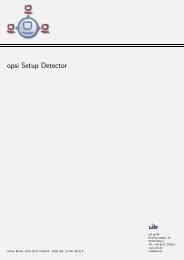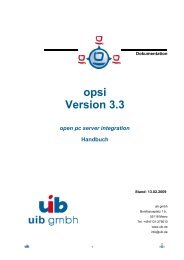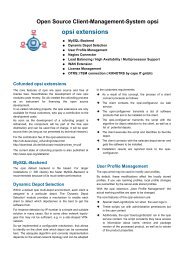opsi Version 3.3.1 - opsi Download - uib
opsi Version 3.3.1 - opsi Download - uib
opsi Version 3.3.1 - opsi Download - uib
Create successful ePaper yourself
Turn your PDF publications into a flip-book with our unique Google optimized e-Paper software.
5. Netboot products: Automated OS installation and more<br />
• The automated software distribution then installs all the software packages as<br />
defined in the client's configuration.<br />
5.1.2. Preconditions<br />
First of all an <strong>opsi</strong> depot server has to be installed.<br />
The client PC has to be equipped with a bootable network controller. Most recent<br />
network controllers provide this functionality (PXE boot), also recent network controllers<br />
which are integrated on the PC's main board. The PXE software, which is stored in the<br />
'bootprom' of the network controller, controls the boot process via network according to<br />
the BIOS boot device sequence. Usually the boot sequence has to be set in the BIOS,<br />
'network-boot' has to be the first boot device.<br />
On request also the support of 'bootp' bootproms is available.<br />
The <strong>opsi</strong> installation package for the OS to be installed needs to be provided on the<br />
depot server. In the following we assume Windows 2000 to be the OS to install.<br />
5.1.3. PC-client boots via the network<br />
The PXE firmware gets activated at startup of the PC. Part of the PXE implementation<br />
is a DHCP client.<br />
Depot-Server<br />
from<br />
/etc/hosts +<br />
/etc/dhcp3/dhcpd.conf<br />
Figure 20: Step 1 during PXE-Boot<br />
dhcpdiscover<br />
dhcpoffer<br />
dhcprequest<br />
dhcpack<br />
76<br />
PC/Client<br />
PXE-Bootprom<br />
becomes active<br />
PC now knows:<br />
- it's IP<br />
- the server<br />
- Gateway and netmask<br />
- bootfilename








